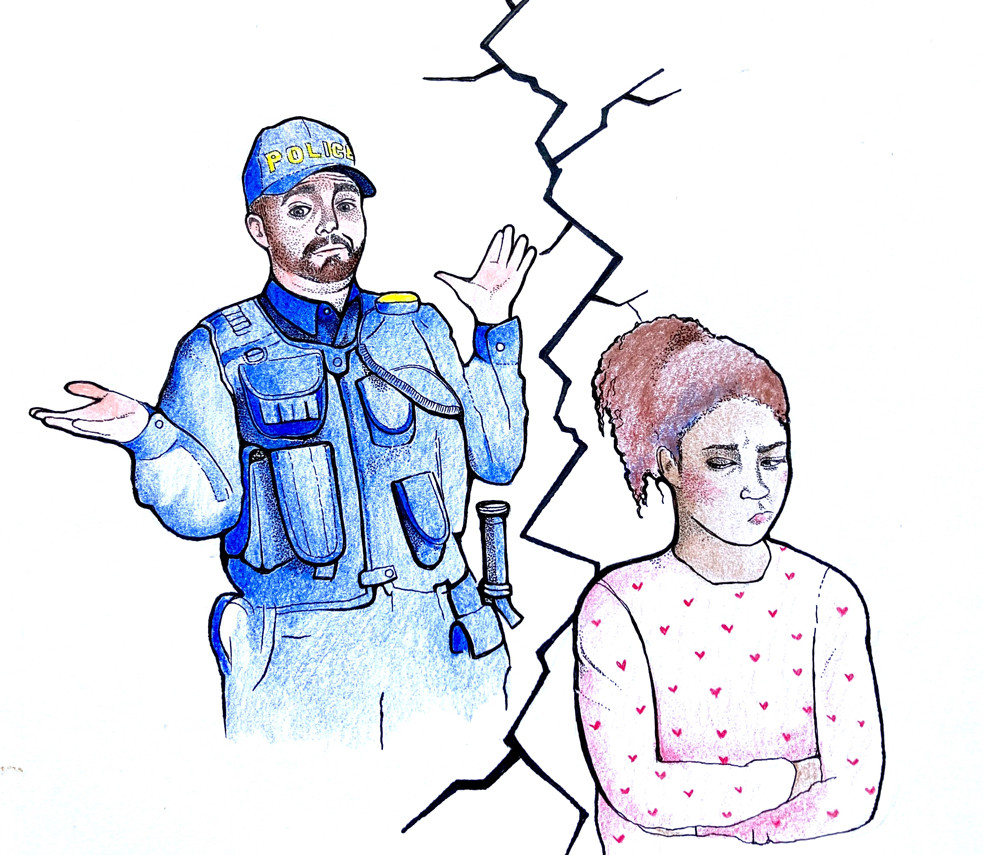Holding accountability to account
Community groups allege structural issues prevent police liability

Illustration by Gabrielle Funk
On Jan. 28, the Independent Investigation Unit of Manitoba (IIU) publicly released a report concluding the officer who shot and killed 16-year-old Eishia Hudson in April 2020 would not face criminal charges. Zane Tessler, a lawyer and the civilian director of the IIU, claimed he was confident that “no stone was left unturned” in the investigation.
In light of the report’s findings, a number of community groups, politicians and advocates have pointed at organizational flaws within the IIU and other institutions meant to hold police accountable.
James Wilt, an organizer with Winnipeg Police Cause Harm (WPCH) argues there are structural issues within the IIU that raise red flags. In 2019, the Winnipeg Free Press (WFP) conducted an investigation that revealed only seven out of the 153 reports that were conducted or monitored by the IIU in nearly three-and-a-half years led to charges.
“The officer who killed Eishia didn’t have to be interviewed for the investigation, and that’s a right police officers have under the current system,” Wilt says.
According to the WFP report, many members of the Winnipeg Police Service (WPS) have resisted cooperation. When the WFP report was published in November 2018, only 23 out of 81 investigated officers had fully cooperated with the IIU since it was established in 2015. While witness officers are required to submit interviews and officer notes to the IIU, the subject officer – alleged to have caused a death – is not.
Wilt also mentions another issue: the overwhelming majority of investigators within the IIU are former members of the police service. In June 2019, the Canadian Press released an investigative report that revealed 111 of the 167 members of independent investigation units in Canada were former police officers. Wilt argues that this creates an unfair bias that can lead to detrimental consequences.
“There’s just so many layers that obscure the actual process behind this,” he says. “We see it as a very deeply compromised institution.”
Events of police violence inflicted on BIPOC youth, like Hudson, do not exist in the vacuum of the IIU. Cam Scott, an organizer with Police-Free Schools Winnipeg (PSFW) says these incidents of violence – especially for racialized, low-income and disabled students – impact how safe marginalized students feel in schools that employ school resource officers (SROs).
“When we think about the killing of Eishia Hudson by the Winnipeg Police Service, imagine how many teenagers had to go to school and see a police officer the next day,” Scott says.
In September 2020, Winnipeg’s city council voted to continue the SRO program, employing 19 officers in schools across the city. However, some community groups, including PFSW have been pushing against their presence in schools.
Scott says PFSW was born, in part, out of the aftermath of Hudson’s death and the calls for justice that followed. The group, which is composed of teachers, parents, students and community members, argues that police presence in schools creates an environment that is traumatic for marginalized students who have had negative encounters or associations with the police.
“A lot of our concern isn’t only about the direct harm that the school resource officers cause in the day-to-day, but about the associations they incarnate that are pushing people out,” Scott says.
A few weeks before the time of writing, a former fifth- and sixth-grade teacher quit his job after a series of negative encounters with an SRO and a dismissal of the issue by the school administration. After the teacher – who said he worked at a school with the highest Indigenous population in the division – went public with his story, Scott says PFSW was “saddened, but also inspired by the story, because it’s so familiar.”
In a personal statement made public, the teacher alleges an SRO “barged into the classroom unannounced” and “pulled down her mask” to “say hello and joke about arresting students.” When the teacher brought up the issue with the school administration, he alleged they were dismissive of his concerns.
Searching for ways to hold SROs accountable for their actions in schools has been a challenge for teachers, students and parents, according to Scott. He says teachers who wish to be critical about a police presence in schools often fear backlash for speaking out.
“When you still have to be this kind of stable presence to children and their families, and you need to get along with your administration, it’s really hard to point out abuses of authority in your own workplace,” Scott says.
As a member of PFSW who does not work as a teacher, Scott says he often speaks publicly on behalf of teachers who fear the workplace repercussions of speaking out.
With local school boards, including the Seven Oaks School Division, declaring anti-racism committees, Scott says recognizing the impact a police presence has on racialized students is crucial, especially in light of Hudson’s death.
“We’re still calling for the complete removal of police from schools as a practical anti-racist measure,” Scott says.
Though the Manitoba Prosecution Service concluded there was “no legal or factual basis” to charge the unnamed officer who killed Hudson, her family, along with other actors, including the Assembly of Manitoba Chiefs, are demanding a deeper look into the 16-year-old’s death.
Nahanni Fontaine, the MLA for St. John’s, forwarded an emergency resolution at the Manitoba NDP convention, calling for an immediate public inquiry into Hudson’s death. Winnipeg police chief Danny Smyth also announced that Manitoba’s chief medical examiner will conduct an inquest into Hudson’s death in an effort to prevent similar situations in the future.
Wilt says WPCH will continue to support the calls to action raised by Hudson’s family and others. The family has stated they will continue to fight for justice in the aftermath of their daughter’s death.
Published in Volume 75, Number 18 of The Uniter (February 11, 2021)






